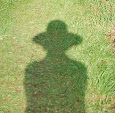There's a new book out which looks at Glasgow hidden gems. I suppose we all have our own list of favourite corners of the city. Glasgow, while it has obvious signs of tourists about the place, is not a 'touristy' city. Edinburgh certainly is no matter what month of the year.
Exploring Glasgow is great fun. Keeping away from the obvious magnets e.g. Charles Rennie MacIntosh (and that includes 'Mockintosh') sites the joy comes from the less obvious attractions ... which is exactly what this book it about.
Before illustrating some sites listed I have to declare an interest from 40 years ago: three other women and I published a similar book called 'Try Glasgow'. It was based on the fact that we found it a great city to live in; it was just hard to find things!
The main driving force was Marian St Onge and Sue Hight and Susan Wallace and I contributed (particularly at the end when dealing with the Milngavie chap, Colin Harvey, who printed it in 1976).
Looking back at it I noticed the wonderful artwork by Margaret Bancewicz. Moira Forrester typed it and Joyce Begbie contributed many ideas. I think the print run was 1500 copies.
What happened afterwards? Sue and Marion (had already) returned to the States and I had my second baby; no more was ever done. I recall Susan and I were interviewed on BBC radio by Magnus Magnusson who said "M-m-m-m... it's a bit of a curate's egg!" I had never heard that expression so just smiled and said nothing. [It means: good in parts]
So what did my friend and I find last week on our exploration?
This chap sells coffee out of a (former) blue police box which is near Glasgow Cathedral. We found him, not because of the book (which we did now know about), but we were looking to have a cup of coffee. It was mid-morning in a practically empty city centre. Schools were out, people were on holiday or glued to the 2018 TV World Cup football.
His name is Rocco and he served us really good coffee from his Italian coffee machine (a proper one) installed inside the police box. We got chatting and he told us how he was No 36 in this new book by Tom Shields.
Tom had given him 5 copies informing him that he was in it. Of course he was chuffed. Having sold 3 he sold us the 2 he had left. He certainly is an oasis in a deserted part of the city in terms of getting a cup of coffee on a Monday morning. (Museum across the road closed. Glasgow Royal Infirmary up the road are regular customers. This is a good example of what I am talking about, i.e. just ordinary people making a difference.. and happy to pass the time of day. In Glasgow they talk about 'good craic' i.e. good'chat'.)
We had already planned to visit Fairfields Shipyard on the other side of the Clyde in Govan. After lunch in the Pearce Institute we strolled down to the river. Looking back at the city I took this photo of Transport Museum and 'Glenlee' in the foreground...... sadly all museum stuff on a river that once was heaving with commerce and shipbuilding.
Even older that the industrial based commerce and shipbuilding era was the fact that this part of the west of Scotland has many archeological remains of viking and early Celtic settlements. This photo above is taken in the churchyard of Govan Parish Church (which houses humpback viking gravestones - properly described as 'hogback' ) [No 50]. But what it also shows is the derelict ground full of weeds which lies between the churchyard perimeter and the edge of the Clyde. It was once an area of heavy river traffic associated with the many shipyards, dockyards and liner and ferry terminals that have now long gone.
Lastly one building that is left is Fairfields Shipyard Museum ... again a pale shade of past years where they built the big liners that went from Glasgow to Canada and USA with thousands of immigrants. The museum is full of memorabilia of this era.
A local initiative saved the office block which, after renovation, shows the beautiful woodwork done by carpenters in the days when they trained as apprentices and used all different types of wood with workmanship of a very high standard. (Precious little of any of that any more!)
The photo shows the front entrance hall as seen from the stairwell above. GS stands for Govan Shipbuilders. I was particularly taken with this building as I used to work in an office that had the same feel to it i.e. where the 'hats' (bowler hatted management) were located above the work floor (cloth caps). It had the same wood flooring and cases for keeping books and linen drawings.
And on our way out to the yard (the original yard with its rail lines still in the ground) we saw Tom Shields red book on the entrance hall front desk. They are in the book too ... another hidden gem at No. 38 - well worth a visit.















